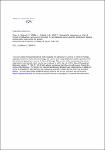Growth of influenza A virus is not impeded by simultaneous removal of the cholesterol binding and acylation sites in the M2 protein
Thaa, Bastian
Tielesch, Claudia
Möller, Lars
Schmitt, Armin O.
Wolff, Thorsten
Bannert, Norbert
Herrmann, Andreas
Veit, Michael
Influenza virus assembly and budding occur in the 'budozone', a coalesced raft domain in the plasma membrane. The viral transmembrane protein M2 is implicated in virus particle scission, the ultimate step in virus budding, probably by wedge-like insertion of an amphiphilic helix into the membrane. In order to do this, M2 is hypothesized to be targeted to the edge of the budozone, mediated by acylation and cholesterol binding. It was recently shown that acylation and cholesterol binding affect the membrane association of the cytoplasmic tail of M2 and targeting of the protein to coalesced rafts. This study tested whether combined removal of the acylation site (C50) and the cholesterol recognition/interaction amino acid consensus motifs (key residues Y52 and Y57) in the amphiphilic helix of M2 influenced virus formation. Recombinant influenza viruses were generated in the influenza strain A/WSN/33 background with mutations in one or both of these features. In comparison with the wild-type, all mutant viruses showed very similar growth kinetics in various cell types. Wild-type and mutant viruses differed in their relative M2 content but not regarding the major structural proteins. The morphology of the viruses was not affected by mutating M2. Moreover, wild-type and mutant viruses showed comparable competitive fitness in infected cells. Lastly, a global comparison of M2 sequences revealed that there are natural virus strains with M2 devoid of both lipid-association motifs. Taken together, these results indicate that the acylation and cholesterol-binding motifs in M2 are not crucial for the replication of influenza virus in cell culture, indicating that other factors can target M2 to the budding site.
No license information
Related Items
Show related Items with similar Title, Author, Creator or Subject.
-
2009-06-12ZeitschriftenartikelInfluenza B virus ribonucleoprotein is a potent activator of the antiviral kinase PKR Dauber, Bianca; Martinez-Sobrido, Luis; Schneider, Jana; Hai, Rong; Waibler, Zoe; Kalinke, Ulrich; Garcis-Sastre, Adolfo; Wolff, ThorstenActivation of the latent kinase PKR is a potent innate defense reaction of vertebrate cells towards viral infections, which is triggered by recognition of viral double-stranded (ds) RNA and results in a translational ...
-
2010-08-04ZeitschriftenartikelVirulence Determinants of Avian H5N1 Influenza A Virus in Mammalian and Avian Hosts: Role of the C-Terminal ESEV Motif in the Viral NS1 Protein Zielecki, Florian; Semmler, Ilia; Kalthoff, Donata; Voss, Daniel; Mauel, Susanne; Gruber, Achim D.; Beer, Martin; Wolff, ThorstenWe assessed the prediction that access of the viral NS1 protein to cellular PDZ domain protein networks enhances the virulence of highly pathogenic avian influenza A viruses. The NS1 proteins of most avian influenza viruses ...
-
2008-11-05ZeitschriftenartikelAnalysis of influenza B virus NS1 protein trafficking reveals a novel interaction with nuclear speckle domains Schneider, Jana; Dauber, Bianca; Melén, Krister; Julkunen, Ilkka; Wolff, ThorstenMany proteins that function in the transcription, maturation, and export of metazoan mRNAs are concentrated in nuclear speckle domains, indicating that the compartment is important for gene expression. Here, we show that ...

